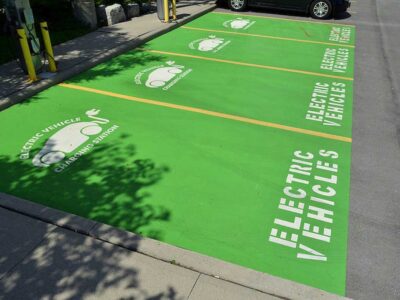Electric Shared Mobility:
Legal Planet: Environmental Law and Policy 2024-09-12

Shared mobility—an umbrella term for any transportation mode shared among multiple passengers—has the potential to accelerate transportation electrification, air quality, and greenhouse gas reduction goals, meet the needs of underserved communities that most lack mobility access, and advance broader mobility equity goals. CLEE’s report, Electric Shared Mobility: California Lessons Learned for Equity in Program Design, highlights examples of electric shared mobility programs and identifies lessons learned for equity-focused program design based on analysis of California projects in two key categories: EV carshare and mobility hubs.
Electric shared mobility can increase access to EVs and zero-emission mobility for those who may be unable to purchase or lease an electric vehicle, do not need or desire a dedicated private vehicle, or are unfamiliar with zero-emission transportation. Shared mobility programs can offer important transportation options for those who do not have the means to buy or maintain a private vehicle or need only periodic vehicle access and lack viable public transit, especially in rural and low-income communities. Electric shared mobility can increase consumer choice, enhance the safety of the transportation system, stimulate new public transit use, and lessen road gridlock. In addition, shared mobility can stimulate community economic activity by increasing foot traffic near shared mobility and transportation hubs and can provide alternative transportation options for first and last mile commutes. Lastly, shared mobility programs also have the potential to reduce total vehicle miles traveled (VMT) by reducing single-occupant vehicle trips, a vital step in long-term sustainable transportation efforts. Incorporating EVs and e-mobility into carshare and mobility hubs can add greenhouse gas emissions reduction and air quality improvements to these mobility benefits.
As local and state governments launch and expand shared mobility programs, department leads and staff should keep several important elements in mind to ensure that these programs are both equitable and effective. For CLEE’s report, we analyzed BlueLA, an EV carshare program in Los Angeles; Green Raiteros, a rideshare program in Huron; Míocar, an all-electric carshare service in Tulare, Richmond, and Stockton; and other electrified shared mobility programs. Electric Shared Mobility: California Lessons Learned for Equity in Program Design makes the following recommendations for decision-makers and designers:
- Pursue public investment and public-private coalitions to enhance program sustainability
- Perform a needs assessment survey before project design, invest in community outreach and education, and incorporate community feedback
- Prioritize underserved communities through accurate site selection and community engagement
- Ensure adequate staffing and early political momentum for programs
- Hire local residents to train and educate others when introducing new programs
- Build on existing community efforts and projects where possible to enhance program utility and increase program durability
Maintaining affordability for low-income communities is also a key consideration when designing shared mobility programs. For some communities, gentrification associated with increased EVs, EV charging, and mobility hubs is a concern and should be addressed. Remedies include preserving existing housing, maintaining tenant-supportive policies through existing incentive programs and planning processes, and carefully thinking through public agency land policies. Anti-displacement plans created by community residents and advocates are another tool.
In the drive to decarbonize transportation, shared mobility programs, including EV carshare programs and zero-emission mobility hubs, can play a key role in meeting both community needs and transition targets by providing carbon-free basic mobility, particularly in areas that have experienced significant disinvestment. The practices identified in Electric Shared Mobility: California Lessons Learned for Equity in Program Design can help these programs ensure that all residents have equal access to clean mobility options.